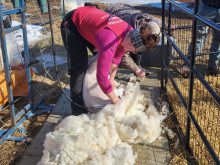VIMY, Alta. – When Bill Lefebvre goes out to cut the grass, he’s likely to be gone for quite a while.
On this six-year-old sod farm at Vimy, about 50 kilometres north of Edmonton, Bill and Delvin Lefebvre are part of the competitive sod business supplying instant lawns to homeowners and businesses in central Alberta.
Vimy Meadow Sod Farm consists of 100 acres of lawn that requires mowing, irrigation and fertilizing to give the lush appearance landscapers demand.
Sod requires a smooth growing bed where all stones and weeds are removed. The bed is then double seeded to 80 percent Kentucky bluegrass with 20 percent creeping red fescue at the rate of 50 to 80 pounds of seed per acre.
Read Also

Charges laid after cattle theft
Saskatchewan RCMP lay two charges against a man after six cattle went missing.
Plants are seeded in two passes. The second pass is seeded crosswise to ensure the lawn fills properly, said Lefebvre.
Fertilizer is applied twice a year. The first application of 250 pounds to the acre goes down when the snow is on the ground in early spring, followed by a slightly heavier spreading of nutrients in June.
A common misconception is that stripping sod removes a lot of topsoil.
“It looks like a lot of dirt is going, but if you check, you’re just cutting under the roots and there’s hardly any dirt going away,” Lefebvre told a farm tour group.
“A lot of people ask the question what do you do when your topsoil runs out. I don’t think that’s something that will ever happen,” he said.
On this farm, the top soil varies from 25 to 120 centimetres deep.
After the grass has been lifted by a special sod stripper, the ground is sprayed with Roundup to clean off weeds. Then it is worked and reseeded. It takes about two years between cuts, said Lefebvre.
Some operations take a crop off every year but the Lefebvres haven’t tried that yet.
Each strip, call a yard of sod, is 81 inches long (205 cm) and 16 inches wide (40 cm). Each roll weighs about 25 pounds (11 kilograms).
It can be watered a couple days before cutting to make the job easier but if it’s too wet, the sods can overheat. Once sods are cut and rolled they are usually laid the next day. They can last for several days in the roll and survive, said Lefebvre.
When they first seeded grass on the property the soil was fine and subject to wind erosion. After the first cropping of grass they noticed improved soil quality.
“We’ve had no problems with erosion whatsoever because a tremendous amount of fibre stays in the soil,” he said. Most of that fibre comes from the fescue.
Nor have winter kill or fairy rings caused by fungus been a problem. Fairy rings tend to be a problem in older, mature lawns so aren’t likely to appear on newly seeded grass, he said.

















